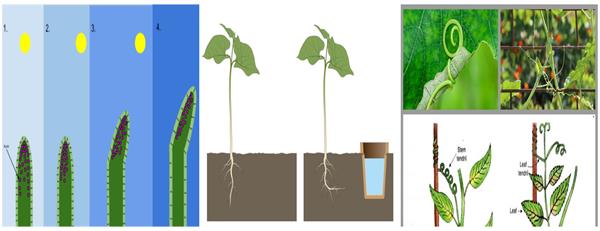
PUMPA - SMART LEARNING
எங்கள் ஆசிரியர்களுடன் 1-ஆன்-1 ஆலோசனை நேரத்தைப் பெறுங்கள். டாப்பர் ஆவதற்கு நாங்கள் பயிற்சி அளிப்போம்
Book Free DemoA wide range of movements occurs in our body. The blinking of our eyes and the contraction and relaxation of the diaphragm during breathing are some of them.
The act of changing position by one or more parts of the body towards the stimulus is known as a movement.
Example:
The movement showed by plants is comparatively slower than in animals.
Have you noticed plants? Not all its movements are visible, but it is still considered living.
Movements also occur at molecular levels. Such movements are also invisible, and they are necessary for life. As studied and discussed, living organisms are well-organized structures composed of cells and tissues primarily made up of molecules and atoms. These molecules are moving inside the cells and other parts. However, due to the various changes that occur in the environment, these structures may break down, finally leading to the organism's death.
Types of movement in living organisms:
Movement in living organisms is classified into three types as follows:
- Continuous movement: These are the movements that occur inside the cells of the living organism. These movements maintain the continuity of its vital activities, such as cytoplasmic streaming, protoplasmic streaming or cyclosis (a continuous rotational movement in one direction inside the cell), which is indicated by the movement of chloroplasts that are embedded in the cytoplasm.
- Positional movement: These movements are seen in some organs of the living organism, such as peristalsis movement in the intestines of vertebrates.
- Total movement: This is a type of movement by which the organism moves from one place to another for nutrition and reproduction or to avoid some dangers. This is also known as locomotion.
Movement in plants:
Movement in plants strictly occurs only as a response to stimuli. Movements in plants are categorized into two such as tropic movements and nastic movements:
1. Tropic movements: The unidirectional movement or growth of a whole part of a plant towards the direction of stimuli is known as tropism.
- Geotropism – The movements of growth towards gravity. It is shown by the roots of Rhizophora and Avicenna.
- Phototropism – The bending of a plant stimulated by the light. The solar tracking of sunflowers following the path of the sun is due to phototropism.
- Hydrotropism – The direction of a plant's growth in relation to water.
- Thigmotropism – The response to the stimulus of touch. It is seen in Mimosa pudica.
- Chemotropism – The movement of a part of a plant in response to chemicals is known as chemotropism. The growth of the pollen tube in response to the sugar content found in the stigma is an example.

Phototropism, hydrotropism and thigmotropism seen in plants
2. Nastic movements: The non-directional movements of a plant or its part in response to the stimulus are known as nastic movements.
It is a phenomenon that differs from tropism as these responses are independent of the direction of the stimulus.
Reference:
https://upload.wikimedia.org/wikipedia/commons/thumb/1/14/Phototropism_Diagram.svg/512px-Phototropism_Diagram.svg.png
https://pixabay.com/photos/vine-tendril-embrace-green-noose-4102328/
https://pixabay.com/photos/cucurbit-climber-tendrils-hung-4460322/
http://lifeofplant.blogspot.com/2011/03/nastic-movements.html